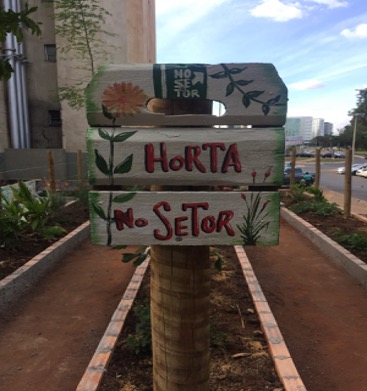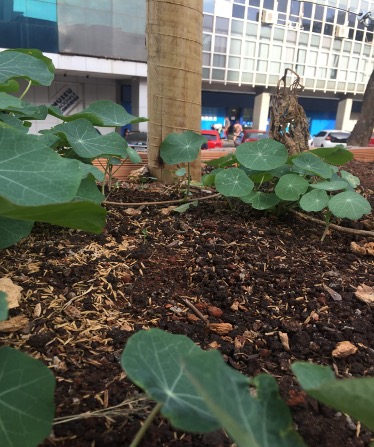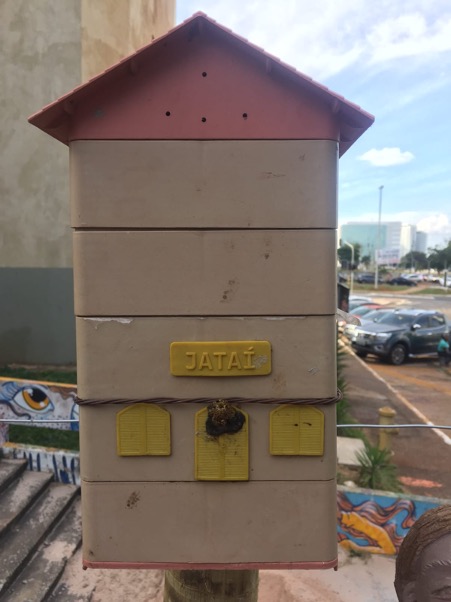Occupy Goes Global!
Brasília
In 2020 OCC! expanded its scope and encouraged students to explore local initiatives in their city, resulting in entries from various locations. Here below you find the entries from Brasília
Scroll for more
In 2020 OCC! expanded its scope and encouraged students to explore local initiatives in their city, resulting in entries from various locations. Here below you find the entries from Brasília
Scroll for more
Marina Salgado Pinto
@nosetor
@jardimnosetor
One simple action can be sufficient to change a situation that has been going on for a long time. That is the case of an urban garden in the Brazilian capital, Brasília, that is changing the lives of many unhoused people in the city. It was a beautiful sunny day when I arrived at the urban garden. I already knew the place, even before the beginning of the project. I used to work right in front of the area where they now plant crops. I remember it was an abandoned place, all cemented, some dirty earth in the middle.
It was very windy that day, and my long dress kept flowing around. I was a bit worried that the wind would disturb the interview. I looked inside the urban garden and saw two guys sitting there, with a soda bottle between them, chatting and having a snack. I noticed the colorful gate and the stalk of a papaya tree wrapping one of the gate’s sticks, like a snake, growing up. A few moments later, Aretha arrived, the woman I was waiting for. We said hi and started our chatting. First, I wanted to know who was responsible for that idea? How was that possible? Well, it wasn’t about just one person because the Jardim das Flores was a collective action. And that was the essential aspect of the entire project.
The project Jardim das Flores belongs to great collective action, the Nosetor Institute. Further, their implemented action, which contemplates cultural activities, the urban garden, and a Sunday fair is responsible for considerable changes in the unhoused lives. As I chatted with Aretha it became clear that the project matches environmental action by greening the city and aspects of social justice as well. Above all, urban gardens have a tremendous effect on the lives of everybody in a city. It changes the way people perceive their city, which leads to a bigger transformation in the city.
Where is this grassroots initiative implemented? Who are the promoters? Who are the beneficiaries?
The project Jardim de Flores – Nosetor was implemented at the South Commercial Center (SCS) in the Brazilian capital, Brasília, and belongs to the cultural and social institute called Nosetor. The purpose of the Nosetor Institute is to bring life back to the Commercial Center, an area long marginalized and forgotten by the local government. Local young people first imagined the Nosetor Institute, and their first action was organizing Carnival parties named Setor Carnavalesco Sul on the streets to attract people to the area. Then, the Nosetor Institute started to organize local actions to offer help to unhoused people, that is, people who were in a very vulnerable situation. In this sense, the first beneficiaries of the urban garden are the unhoused people who can count on the urban vegetable/herb garden as a source of organic and healthy food. In addition, as a space where they feel welcome. As key workers, among the volunteers, in the urban garden, they restore their sense of value through therapeutic activities, like gardening, and, above all, see themselves as valuable community members.

The sign indicating the space designated for the garden. Image by Marina Salgado.
How does this initiative engage with climate? Does it tackle mitigation, adaptation, both or other dimensions of climate change?
The Jardim das Flores goes straight to undermining the massive presence of concrete in urban areas. The project works as a relevant tool against environmental destruction and towards a more sustainable human and nature relationship. Physically, among many other benefits, the presence of urban green areas helps mitigate the effect of atmospheric pollution, enhancing the rainwater absorption in the soil, which helps avoid floods, particularly in less wealthy areas. Furthermore, as many studies have shown, human society benefits substantially from contact with nature. Finally, nature areas can help humans with many issues associated with people who live in urban spaces, such as anxiety and depression.
What are the main objectives? What are the main values?
The main goal of the project, not only the urban garden but the work undertaken by the Nosetor Institute is to offer support to the unhoused people and those in noticeably vulnerable situations. One of the institute members, Areta Monteiro, says that contact with unhoused people enriches life as a way to help us to see beyond our bubble. The urban garden department at Nosetor Institute is composed of three people with different academic backgrounds. Areta has a degree in Environmental Science, Bruno is an environmental manager, and José Grossi is an environmental scientist. But, Areta highlighted they learn a lot from the unhoused people who volunteer at the garden: “We learn many things from people on the street (…) many of them teach us how to plant, about the usefulness of plants. Having a degree is not everything”.

Detail of a Taioba (Xanthosoma saggitifolium (L.) Schott), an example of a PANC (unconventional food plant) growing in the urban garden Jardim das Flores. Behind, detail of a building in the South Commercial Center (SCS). Image by Marina Salgado.
What is the timeline? Are there already visible effects?
In 2018, as a collective action, Brasília’s local young residents organized Carnaval parties as an alternative to stimulate cultural activities in a marginalized area of the town, the Brazília’s Commercial Center. The creation of the project happened between the years 2018 and 2019 through the Verdejando project, an action involving another local urban garden, Aroeiras, and the Brazilian television channel Rede Globo. Together, they undertook the urban garden in the area where it’s still operating. In 2020, the Covid pandemic affected the urban garden’s activities. In August of the year 2020, they restarted the activities.
The effects of the project are observable in many different ways. As it concerns climate change, the urban garden helps alter the area’s landscape, bringing green to the profusion of cement that characterizes the Commercial Center. Additionally, it is a grassroots action mobilizes the community through donations and volunteer work. Furthermore, the urban garden helps spread knowledge about growing crops and information about plants. To the unhoused inhabitants of the Commercial Center, the project offers them a space to recover their faith in themselves. In the end, they are intelligent and capable people who suffer from violence and are made invisible by this “crazy society” in the words of Areta.
In the future, the people responsible for the urban garden want to expand the project towards an educative approach to the area. They want the urban vegetable garden to be a place for environmental education. They intend to turn the urban vegetable garden into a laboratory. That is a space where people and student classes could visit to learn about gardening, plants, insects (the urban vegetable garden also counts with small beekeeping), and the unhoused would be the teacher guides.

Detail of beekeeping. Image by Marina Salgado.
Who are the actors involved? What is their background?
The Nosetor Institute is composed of local young people. Most of them began as volunteers in the different projects and then were absorbed to work in the departments as the project grew. They also count on the help of many local artists that donated artwork in one of their manners to finance their activities. The key workers of the project are the unhoused people due to the primary initiative’s objective, which is to offer them a tool of emancipation. The local community is another source of help through their donations of, for instance, plant seedlings and gardening tools.
Despite many conflict situations with the Federal District Government, the Nosetor Institute also counts on the support offered by some local political figures, such as Plano Piloto’s Administrator Ilka Teodoro.

Some of the guys who work at the urban garden, in the back, enjoying a snack. Image by Marina Salgado.
Which limits does it encounter?
The principal limitation faced by the urban vegetable gardens responsibles is institutional. The Commercial Center struggles with a few problems, like violence, and shows a high risk for robbery, for instance. That is because of the government’s negligence. On the other hand, since the beginning of cultural activities organized by local community members, like Samba parties and Carnaval, robbery cases have decreased.
Another South Commercial Center (SCS) problem is the drug abuse in the area. The police approach to this problem is frequently using violence to repress. Still, the cultural activities organized by the local community have shown better results in tackling drug abuse in the area and helping people in vulnerable situations.
Nevertheless, the first and principal limitation faced by the Jardim das Flores is the conflicts with the local police. They accuse the place of being a potential hiding place for drugs and weapons. Another source of conflict is the Federal District Government. They use hygienist policies to evict people from the area. For instance, on November 19th, 2020, Novacap (Brasília’s administration) took away the unhoused’s properties. They also threatened to destroy the Jardim das Flores.
Finally, the place constantly struggles with night-invasion situations (sometimes by dogs that cave the area) and plant seedlings robbery. But, the people responsible say the unfortunate events they face are part of the process.

The new front gate, a way to avoid invasion. Image by Marina Salgado.
Are any shortcomings or critical points visible? What other problematic issues can
arise from its implementation?
The Jardim das Flores is in a small area, which limits its expansion.
How would it be potentially replicable in other settings?
The concept of an urban vegetable and herb garden is not original to the Nosetor Institute, and there are different examples of this grassroots initiative all over the world. Their particularity is to involve vulnerable people as the key project subjects. The goal is to articulate unhoused people with the community through environmental activities that mitigate the effects of climate change.
The Jardim das Flores organizers are developing a manual offering help to people who desire to replicate the project in other places in Brasília and in other cities.
Is this initiative conducive to broader changes?
Yes, this initiative mobilizes popular participation and builds bridges between city dwellers and homeless people. Currently, the Nosetor Institute organizes a Sunday fair, and they were responsible for establishing legal measures that guarantee the permanence of unhoused people in the region. Their goal is to expand the project to other parts of the city and the country.
Due to the conflicts with the police, the Nosetor members are more and more involved with political issues. They are constantly sharing in their social media when they participate in political plenary. The truth is that everything started with a group of young people who wanted to party but didn’t have a place to do so. When occupying the abandoned South Commercial Center area, they broke the separation between them and the unhoused who lived there. The project then expanded to help mitigate the effects of other urgent issues, such as climate change. Finally, the urban garden changed the life of many people, not just the unhoused but anyone who goes through the area, including me. The ugly abandoned place in front of the place I used to work is now a beautiful garden, and the unhoused people of the area, so close to us and so far away at the same time, became someone we know, we say hi, we chat, we share a snack, a coffee, a smile.